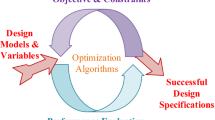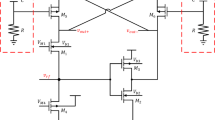Abstract
The complexity of radiofrequency circuit design comes from the large number of parameters to be adjusted. Constant node shrink in CMOS process and variation of technology skills significantly contribute to this complexity. The paper reports on a reliable and portable design methodology based on a low-power figure of merit (FOM) and inversion coefficient applied to the design of a low noise amplifier (LNA). The design procedure considers the circuit specifications and the optimization of the FOM. As a case of study it is applied to 2.4 GHz LNA designed in a 28 nm technology then exploited to compare different CMOS technology nodes: 28, 65, 130 nm.

























Similar content being viewed by others
References
Dumesnil, E., Nabki, F., and Boukadoum, M. (2014). « RF-LNA circuit synthesis by genetic algorithm-specified artificial neural network. In 2014 21st IEEE international conference on electronics, circuits and systems (ICECS) (pp. 758–761).
Rahnama, M., Gilmalek, Y. M., and Kordalivand, A. M. (2010). Ultra wide-band LNA using RFCMOS technology and tunability band with neural network. In 2010 IEEE control and system graduate research colloquium (ICSGRC) (pp. 75–79).
Enz, C. C., & Vittoz, E. A. (2006). Charge-based MOS transistor modeling. Chichester: Wiley.
Tsividis, Y. (1999). Operation and modeling of the MOS transistor (2nd ed.). New York: Mc-Graw Hill.
Vittoz, E. A., & Fellrath, J. (1977). CMOS analog integrated circuits based on weak inversion operation. IEEE Journal of Solid-State Circuits, 12(3), 224–231.
Song, I., & Park, B.-G. (2008). A simple figure of merit of RF MOSFET for low-noise amplifier design. IEEE Electron Device Letters, 29(12), 1380–1382.
Shameli, A., Heydari, P. (2004). Ultra-low power RFIC design using moderately inverted MOSFETs: An analytical/experimental study, RFCI.
Mangla, A., Chalkiadaki, M.-A., Fadhuile, F., Taris, T., Deval, Y., & Enz, C. C. (2013). Design methodology for ultra low-power analog circuits using next generation BSIM6 MOSFET compact model. Microelectronics Journal, 44(7), 570–575.
Deen, M. J., Chen, C.-H., Asgaran, S., Rezvani, G., Tao, J., & Kiyota, Y. (2006). High-frequency noise of modern MOSFETs: Compact modeling and measurement issues. IEEE Transactions on Electron Devices, 53(9), 2062–2081.
Ng, T. C., Swe, T. N., Yeo, K.-S., Chew, K. W., Ma, J.-G., & Do, M. (2001). Small signal model and efficient parameter extraction technique for deep submicron MOSFETs for RF applications. IEEE Proceedings of Circuits Devices Systems, 148(1), 35–39.
Enz, C. C., & Cheng, Y. (2000). MOS transistor modeling for RF IC design. IEEE Journal of Solid-State Circuits, 35(2), 186–201.
Author information
Authors and Affiliations
Corresponding author
Rights and permissions
About this article
Cite this article
Fadhuile, F., Taris, T., Deval, Y. et al. Design methodology for low power RF LNA based on the figure of merit and the inversion coefficient. Analog Integr Circ Sig Process 87, 275–287 (2016). https://doi.org/10.1007/s10470-016-0718-0
Received:
Revised:
Accepted:
Published:
Issue Date:
DOI: https://doi.org/10.1007/s10470-016-0718-0




